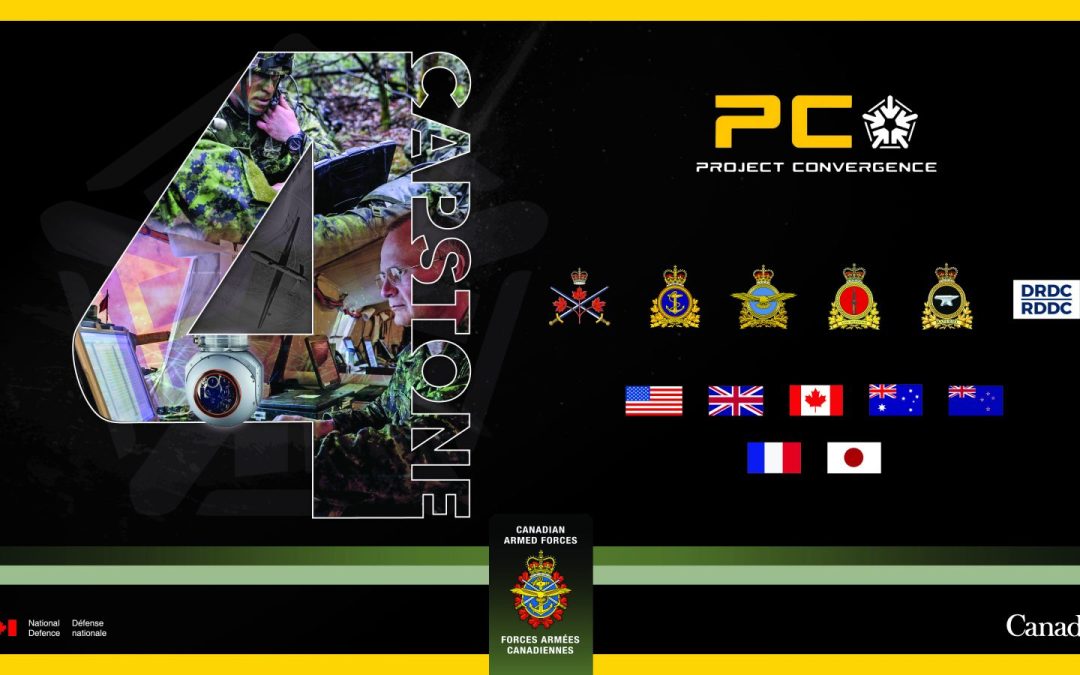by Chris Thatcher
As this edition was going into production, approximately 80 people from various organizations across the Canadian Armed Forces (CAF) and Defence Research and Development Canada (DRDC) were departing for California and the U.S. Army’s National Training Center at Fort Irwin.
Their destination was the fourth iteration of Project Convergence, called Capstone 4, a U.S. Army Futures Command-led experimentation from late February to mid March for multinational interoperability — this time focused on layered air and missile defence.
The size of the Canadian contingent, led by the Canadian Army Land Warfare Centre (CALWC), was significant. For the first time, the CAF attended as a full participant rather than a keen observer.
Project Convergence (PC) has become a key interoperability event for the American, British, Canadian, Australian and New Zealand (ABCANZ) armies, noted Colonel Jim Smith, director of CALWC, and it’s part of a broader effort by CALWC to reinvigorate experimentation in the Army.
“Project Convergence, with its broad scope of experimental capabilities and with the resources that the U.S. Army Futures Command can bring to bear, represents an excellent opportunity for the Army and CAF to ‘dip a toe’ into experimentation without the burden of shouldering the entire cost of planning and executing such a complex experiment,” said Smith.
“We see benefit in bringing novel technological solutions to PC where we can derive value for ourselves, but also contribute in a meaningful way to assist the development of similar technologies that our allies are also interested in.”
Among the capabilities under the microscope were Multimodal Input Surveillance and Tracking (MIST) and Joint Algorithmic Warfighter Sensor (JAWS).
MIST is an airborne artificial intelligence and machine learning (AI/ML)-enabled capability to automatically detect, identify and track targets. It was developed by Kelowna-based Terras Sense Analytics under an Innovation for Defence Excellence and Security (IDEaS) challenge, and is intended to accelerate the sensor-to-shooter response by reducing the processing time and analyst effort with sensor data.
JAWS takes AI/ML enabled processing to the tactical edge by ingesting data from a wide variety of sensors and then employing AI to assist in rapidly identifying targets. It was developed by DRDC Valcartier and has been trialed and evolved over the past several years (see the Spring 2020 edition).
MIST is at Technology Readiness Level 6 while JAWS is TRL 7. “But they essentially answer the same types of questions,” Smith noted. And both technologies could have significant benefits for the Intelligence and Fires enterprises.
PC marked the first time MIST was integrated on an aircraft — a National Research Council Convair 580 — connected to a coalition network via a Canadian LAN, and “employed as part of the sensor-to-shooter thread supporting multinational shooters,” he said. “It is hoped that this experiment will illuminate technical and operational challenges that can be considered during the next iteration of testing to advance this capability further.”
With JAWS, the aim was to understand “how AI/ML technologies can improve performance of tactically deployed teams such as Joint Terminal Attack Controllers and others to identify targets more rapidly, reducing the speed at which they can be engaged.”
While there is considerable interest in applications for AI/ML across the CAF, the Army’s primary interest is the network backbone and the movement of data, said Smith. “By connecting to this mission partner environment, we are going to be informing future evolutions of our networks, whether federated with NATO or hubs with U.S. allies in the Indo-Pacific or Europe.”
The nascent command-and-control information system and other networks being introduced in Latvia will likely involve many of the same engineers “gathering insights from our time in California,” he noted. PC experiments “will inform the networks rolling out [in Latvia] in the next eight months.”
Experimentation has become a driving theme under Army commander Lieutenant-General Joe Paul. Last year, CALWC stood up an Experimentation Services Centre as a means of kick-starting and facilitating more trials across the Army. Tapping into the strength and resources of PC is another way to further experimental opportunities, said Smith, but it’s just “one gateway.”
And as valuable as PC will be to the Army, to a certain extent the 18-month lead up was even more rewarding. Many of the PC participants, including the Royal Canadian Air Force, Canadian Special Operations Forces Command, and DRDC conducted a confirmation exercise in Valcartier in the weeks before PC that opened a raft of new questions about AI/ML applications.
“Rapid evolution is happening,” said Smith, “and we need to have another event sometime between now and Bold Quest,” the next major U.S.-led multinational experimentation opportunity planned for the fall, which will be conducted under the CAF’s Project Olympus initiative.
“We will leverage the Joint Operation Fusion Lab in Ottawa, the Battle Lab we share with General Dynamics Mission Systems, and our research facility in Valcartier … to push the data back and forth amongst them.”


Good Morning,
I was hoping you might be able to shine some light on Kwesst Micro Systems? Are they a very big player in defense for the Canadian Armed Forces, if you know?
Thanks
Joe Gallagher